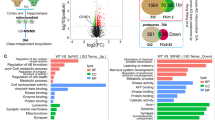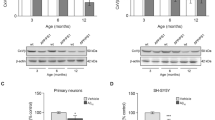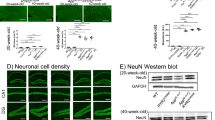Abstract
Cyclophilin D (CypD, encoded by Ppif) is an integral part of the mitochondrial permeability transition pore, whose opening leads to cell death. Here we show that interaction of CypD with mitochondrial amyloid-β protein (Aβ) potentiates mitochondrial, neuronal and synaptic stress. The CypD-deficient cortical mitochondria are resistant to Aβ- and Ca2+-induced mitochondrial swelling and permeability transition. Additionally, they have an increased calcium buffering capacity and generate fewer mitochondrial reactive oxygen species. Furthermore, the absence of CypD protects neurons from Aβ- and oxidative stress–induced cell death. Notably, CypD deficiency substantially improves learning and memory and synaptic function in an Alzheimer's disease mouse model and alleviates Aβ-mediated reduction of long-term potentiation. Thus, the CypD-mediated mitochondrial permeability transition pore is directly linked to the cellular and synaptic perturbations observed in the pathogenesis of Alzheimer's disease. Blockade of CypD may be a therapeutic strategy in Alzheimer's disease.
This is a preview of subscription content, access via your institution
Access options
Subscribe to this journal
Receive 12 print issues and online access
$209.00 per year
only $17.42 per issue
Buy this article
- Purchase on SpringerLink
- Instant access to full article PDF
Prices may be subject to local taxes which are calculated during checkout






Similar content being viewed by others
References
Mauren, I., Zierz, S. & Moller, H.J. A selective defect of cytochrome c oxidase is present in brain of Alzheimer disease patients. Neurobiol. Aging 21, 455–462 (2000).
Blass, J.P. The mitochondrial spiral. An adequate cause of dementia in the Alzheimer's syndrome. Ann. NY Acad. Sci. 924, 170–183 (2000).
Sheehan, J.P. et al. Calcium homeostasis and reactive oxygen species production in cells transformed by mitochondria from individuals with sporadic Alzheimer's disease. J. Neurosci. 17, 4612–4622 (1997).
Cardoso, S.M., Santana, I., Swerdlow, R.H. & Oliveira, C.R. Mitochondria dysfunction of Alzheimer's disease cybrids enhances Aβ toxicity. J. Neurochem. 89, 1417–1426 (2004).
Lin, M.T. & Beal, M.F. Alzheimer's APP mangles mitochondria. Nat. Med. 12, 1241–1243 (2006).
Caspersen, C. et al. Mitochondrial Aβ: a potential focal point for neuronal metabolic dysfunction in Alzheimer's disease. FASEB J. 19, 2040–2041 (2005).
Manczak, M. et al. Mitochondria are a direct site of Aβ accumulation in Alzheimer's disease neurons: implications for free radical generation and oxidative damage in disease progression. Hum. Mol. Genet. 15, 1437–1449 (2006).
Takuma, K. et al. ABAD enhances Aβ-induced cell stress via mitochondrial dysfunction. FASEB J. 19, 597–598 (2005).
Lustbader, J.W. et al. ABAD directly links Aβ to mitochondrial toxicity in Alzheimer's disease. Science 304, 448–452 (2004).
Reddy, P.H. Amyloid precursor protein–mediated free radicals and oxidative damage: implications for the development and progression of Alzheimer's disease. J. Neurochem. 96, 1–13 (2006).
Wang, J. et al. Hepatitis C virus non-structural protein NS5A interacts with FKBP38 and inhibits apoptosis in Huh7 hepatoma cells. FEBS Lett. 580, 4392–4400 (2006).
Shukkur, E.A. et al. Mitochondrial dysfunction and tau hyperphosphorylation in Ts1Cje, a mouse model for Down syndrome. Hum. Mol. Genet. 15, 2752–2762 (2006).
Hirai, K. et al. Mitochondrial abnormalities in Alzheimer's disease. J. Neurosci. 21, 3017–3023 (2001).
Crouch, P.J. et al. Copper-dependent inhibition of human cytochrome c oxidase by a dimeric conformer of amyloid-β1–42. J. Neurosci. 25, 672–679 (2005).
Devi, L., Prabhu, B.M., Galati, D.F., Avadhani, N.G. & Anandatheerthavarada, H.K. Accumulation of amyloid precursor protein in the mitochondrial import channels of human Alzheimer's disease brain is associated with mitochondrial dysfunction. J. Neurosci. 26, 9057–9068 (2006).
Fernandez-Vizarra, P. et al. Intra- and extracellular Aβ and PHF in clinically evaluated cases of Alzheimer's disease. Histol. Histopathol. 19, 823–844 (2004).
Chen, X., Stern, D. & Yan, S.D. in Neurobiology of Alzheimer's Disease (eds. Dawbarn, D. & Allen, S.J.) 227–244 (Oxford University Press, Oxford, 2007).
Cardoso, S.M., Santos, S., Swerdlow, R.H. & Oliveira, C.R. Functional mitochondria are required for amyloid β–mediated neurotoxicity. FASEB J. 15, 1439–1441 (2001).
Crompton, M. Mitochondria and aging: a role for the permeability transition? Aging Cell 3, 3–6 (2004).
Halestrap, A.P., McStay, G.P. & Clarke, S.J. The permeability transition pore complex: another view. Biochimie 84, 153–166 (2002).
Halestrap, A. Biochemistry: a pore way to die. Nature 434, 578–579 (2005).
Zamzami, N., Larochette, N. & Kroemer, G. Mitochondrial permeability transition in apoptosis and necrosis. Cell Death Differ. 12 Suppl 2, 1478–1480 (2005).
Crompton, M., Barksby, E., Johnson, N. & Capano, M. Mitochondrial intermembrane junctional complexes and their involvement in cell death. Biochimie 84, 143–152 (2002).
Halestrap, A.P. Calcium, mitochondria and reperfusion injury: a pore way to die. Biochem. Soc. Trans. 34, 232–237 (2006).
Bernardi, P. et al. The mitochondrial permeability transition from in vitro artifact to disease target. FEBS J. 273, 2077–2099 (2006).
Crompton, M., Virji, S. & Ward, J.M. Cyclophilin-D binds strongly to complexes of the voltage-dependent anion channel and the adenine nucleotide translocase to form the permeability transition pore. Eur. J. Biochem. 258, 729–735 (1998).
Halestrap, A.P., Woodfield, K.Y. & Connern, C.P. Oxidative stress, thiol reagents, and membrane potential modulate the mitochondrial permeability transition by affecting nucleotide binding to the adenine nucleotide translocase. J. Biol. Chem. 272, 3346–3354 (1997).
Connern, C.P. & Halestrap, A.P. Recruitment of mitochondrial cyclophilin to the mitochondrial inner membrane under conditions of oxidative stress that enhance the opening of a calcium-sensitive non-specific channel. Biochem. J. 302, 321–324 (1994).
Andreeva, L., Heads, R. & Green, C.J. Cyclophilins and their possible role in the stress response. Int. J. Exp. Pathol. 80, 305–315 (1999).
Baines, C.P. et al. Loss of cyclophilin D reveals a critical role for mitochondrial permeability transition in cell death. Nature 434, 658–662 (2005).
Pastorino, J.G., Chen, S.T., Tafani, M., Snyder, J.W. & Farber, J.L. The overexpression of Bax produces cell death upon induction of the mitochondrial permeability transition. J. Biol. Chem. 273, 7770–7775 (1998).
Nakagawa, T. et al. Cyclophilin D–dependent mitochondrial permeability transition regulates some necrotic but not apoptotic cell death. Nature 434, 652–658 (2005).
Basso, E. et al. Properties of the permeability transition pore in mitochondria devoid of cyclophilin D. J. Biol. Chem. 280, 18558–18561 (2005).
Schinzel, A.C. et al. Cyclophilin D is a component of mitochondrial permeability transition and mediates neuronal cell death after focal cerebral ischemia. Proc. Natl. Acad. Sci. USA 102, 12005–12010 (2005).
Yan, Y. et al. Surface plasmon resonance and nuclear magnetic resonance studies of ABAD-Aβ interaction. Biochemistry 46, 1724–1731 (2007).
Aguilar, M.I. & Small, D.H. Surface plasmon resonance for the analysis of β-amyloid interactions and fibril formation in Alzheimer's disease research. Neurotox. Res. 7, 17–27 (2005).
Bergersen, L.H., Storm-Mathisen, J. & Gundersen, V. Immunogold quantification of amino acids and proteins in complex subcellular compartments. Nat. Protoc. 3, 144–152 (2008).
Vitolo, O.V. et al. Amyloid β-peptide inhibition of the PKA/CREB pathway and long-term potentiation: reversibility by drugs that enhance cAMP signaling. Proc. Natl. Acad. Sci. USA 99, 13217–13221 (2002).
Klann, E., Roberson, E.D., Knapp, L.T. & Sweatt, J.D. A role for superoxide in protein kinase C activation and induction of long-term potentiation. J. Biol. Chem. 273, 4516–4522 (1998).
Kamsler, A. & Segal, M. Paradoxical actions of hydrogen peroxide on long-term potentiation in transgenic superoxide dismutase-1 mice. J. Neurosci. 23, 10359–10367 (2003).
Naga, K.K., Sullivan, P.G. & Geddes, J.W. High cyclophilin D content of synaptic mitochondria results in increased vulnerability to permeability transition. J. Neurosci. 27, 7469–7475 (2007).
Eliseev, R.A. et al. Role of cyclophilin D in the resistance of brain mitochondria to the permeability transition. Neurobiol. Aging 28, 1532–1542 (2007).
Morais Cardoso, S., Swerdlow, R.H. & Oliveira, C.R. Induction of cytochrome c-mediated apoptosis by amyloid β 25–35 requires functional mitochondria. Brain Res. 931, 117–125 (2002).
Moreira, P.I., Santos, M.S., Moreno, A., Rego, A.C. & Oliveira, C. Effect of amyloid β-peptide on permeability transition pore: a comparative study. J. Neurosci. Res. 69, 257–267 (2002).
Maragos, W.F. et al. Methamphetamine toxicity is attenuated in mice that overexpress human manganese superoxide dismutase. Brain Res. 878, 218–222 (2000).
Hensley, K. et al. A model for β-amyloid aggregation and neurotoxicity based on free radical generation by the peptide: relevance to Alzheimer disease. Proc. Natl. Acad. Sci. USA 91, 3270–3274 (1994).
Serrano, F. & Klann, E. Reactive oxygen species and synaptic plasticity in the aging hippocampus. Ageing Res. Rev. 3, 431–443 (2004).
Liu, R. et al. Reversal of age-related learning deficits and brain oxidative stress in mice with superoxide dismutase/catalase mimetics. Proc. Natl. Acad. Sci. USA 100, 8526–8531 (2003).
Esposito, L. et al. Reduction in mitochondrial superoxide dismutase modulates Alzheimer's disease-like pathology and accelerates the onset of behavioral changes in human amyloid precursor protein transgenic mice. J. Neurosci. 26, 5167–5179 (2006).
Arancio, O. et al. RAGE potentiates Aβ-induced perturbation of neuronal function in transgenic mice. EMBO J. 23, 4096–4105 (2004).
Yan, S.D. et al. RAGE and amyloid-β peptide neurotoxicity in Alzheimer's disease. Nature 382, 685–691 (1996).
Xie, C.W. Calcium-regulated signaling pathways: role in amyloid β–induced synaptic dysfunction. Neuromolecular Med. 6, 53–64 (2004).
Origlia, N. et al. Receptor for advanced glycation end product-dependent activation of p38 mitogen-activated protein kinase contributes to amyloid-β–mediated cortical synaptic dysfunction. J. Neurosci. 28, 3521–3530 (2008).
Hou, F.F. et al. Receptor for advanced glycation end products on human synovial fibroblasts: role in the pathogenesis of dialysis-related amyloidosis. J. Am. Soc. Nephrol. 13, 1296–1306 (2002).
Murakami, K. et al. Mitocondrial susceptibility to oxidative stress exacerbates cerebral infarction that follows permanent focal cerebral ischemia in mutant mice with manganese superoxide dismutase deficiency. J. Neurosci. 18, 205–213 (1998).
Friberg, H., Connern, C., Halestrap, A.P. & Wieloch, T. Differences in the activation of the mitochondrial permeability transition among brain regions in the rat correlate with selective vulnerability. J. Neurochem. 72, 2488–2497 (1999).
Acknowledgements
This work was supported by the US Public Health Service Commissioned Corps (PO1 AG17490, PO50 AG08702) and the Alzheimer's Association. We thank S. Katz for assistance with performing the behavioral experiments.
Author information
Authors and Affiliations
Contributions
H.D. designed and did experiments and assisted with the preparation of the manuscript. L.G. contributed to the study of in vitro cultured neurons. F.F. did quantitative real-time PCR experiments. L.G. and D.C. performed genotyping of transgenic mice. A.A.S. and G.M.M. conducted electron microscopy studies. Y.Y. and C.W. performed surface plasmon resonance experiments. F.J.G.-M. provided some suggestions. J.D.M. provided CypD-knockout mice. H.Z. and O.A. performed LTP experiments. J.P.V. provided information of human brain tissues. J.X.C. provided suggestions for the experimental design and assisted with the preparation of manuscript. S.D.Y. initiated, directed and supervised the research, designed and assisted experiments, analyzed data, developed the concept and wrote the manuscript.
Corresponding author
Supplementary information
Supplementary Text and Figures
Supplementary Figs. 1–6, Supplementary Table 1 and Supplementary Methods (PDF 1408 kb)
Rights and permissions
About this article
Cite this article
Du, H., Guo, L., Fang, F. et al. Cyclophilin D deficiency attenuates mitochondrial and neuronal perturbation and ameliorates learning and memory in Alzheimer's disease. Nat Med 14, 1097–1105 (2008). https://doi.org/10.1038/nm.1868
Received:
Accepted:
Published:
Issue Date:
DOI: https://doi.org/10.1038/nm.1868



